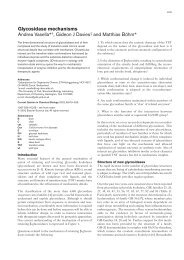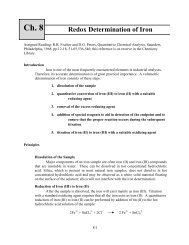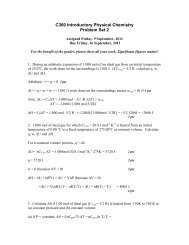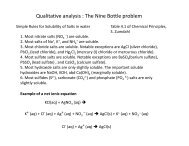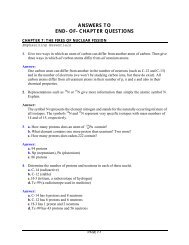ANSWERS TO END-OF-CHAPTER QUESTIONS
ANSWERS TO END-OF-CHAPTER QUESTIONS
ANSWERS TO END-OF-CHAPTER QUESTIONS
You also want an ePaper? Increase the reach of your titles
YUMPU automatically turns print PDFs into web optimized ePapers that Google loves.
Exploring Extensions<br />
52. The aluminum–air battery is being explored for use in automobiles. In this battery, aluminum<br />
metal undergoes oxidation to Al 3+ and forms Al(OH)3. Oxygen from the air undergoes<br />
reduction to OH – ions.<br />
a. Write equations for the oxidation and reduction half-reactions. Use H2O as needed to<br />
balance the number of hydrogen atoms present, and add electrons as needed to balance the<br />
charge.<br />
b. Add the half-reactions to obtain the equation for the overall reaction in this cell.<br />
c. Specify which half-reaction occurs at the anode and which occurs at the cathode in the<br />
battery.<br />
d. What are the benefits of the widespread use of the aluminum–air battery? What are<br />
some of the limitations? Write a brief summary of your findings.<br />
e. What is the current state of development of this battery? Is it in use in any vehicles at<br />
the present time? What is its projected future use?<br />
Answer:<br />
a. Al + 3 H2O ⎯→ Al(OH)3 + 3 H + + 3 e – half-reaction of oxidation<br />
O2 + 2 H2O + 4 e – ⎯→ 4 OH – half-reaction of reduction<br />
b. To make the number of electrons the same, the first half-reaction must be multiplied by 4,<br />
and the second half-reaction must be multiplied by 3. In this way, 12 moles of electrons are<br />
exchanged in the overall reaction.<br />
4 (Al + 3 H2O ⎯→ Al(OH)3 + 3 H + + 3 e – )<br />
3 (O2 + 2 H2O + 4 e – ⎯→ 4 OH – )<br />
The net equation is 4 Al + 3 O2 + 6 H2O ⎯→ 4 Al(OH)3.<br />
c. The half-reaction of oxidation, Al + 3 H2O ⎯→ Al(OH)3 + 3 H + + 3 e – , occurs at the<br />
anode.<br />
The half-reaction of reduction, O2 + 2 H2O + 4 e – ⎯→ 4 OH – , occurs at the cathode.<br />
d. Potential benefits are that aluminum is recyclable, non-combustible, and it is capable of<br />
storing a lot of energy. An aluminum–air battery is quite light and uses air as a reactant. It is a<br />
non-polluting source of power. Some of the limitations are that obtaining aluminum from its<br />
ore is a very energy-intensive process. Even recycling aluminum in a large volume requires<br />
considerable energy, potentially limiting the cost and availability of aluminum. In early<br />
versions of the battery, the electrolyte degraded the aluminum even when the battery was not<br />
in use. Recently, companies have overcome this problem.<br />
e. Despite twenty-five years of research to develop the aluminum–air battery, its use has been<br />
mostly in military applications and no commercial products use the technology. A French<br />
company, Métalectrique (http://www.metalectrique.com), is developing aluminum–air<br />
batteries for use in mobile refrigerators, electric cars, and electric wheelchairs.<br />
53. An iron-based “superbattery” is a promising alternative for delivering more power with<br />
fewer environmental effects than alkaline batteries. Find out how the superbattery is designed<br />
and its state of commercial acceptance.<br />
PAGE 8-18



